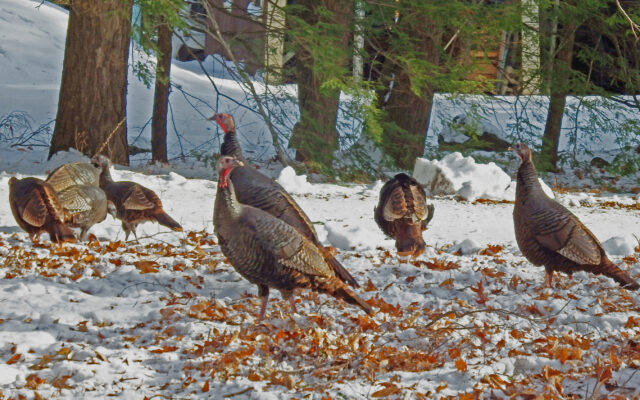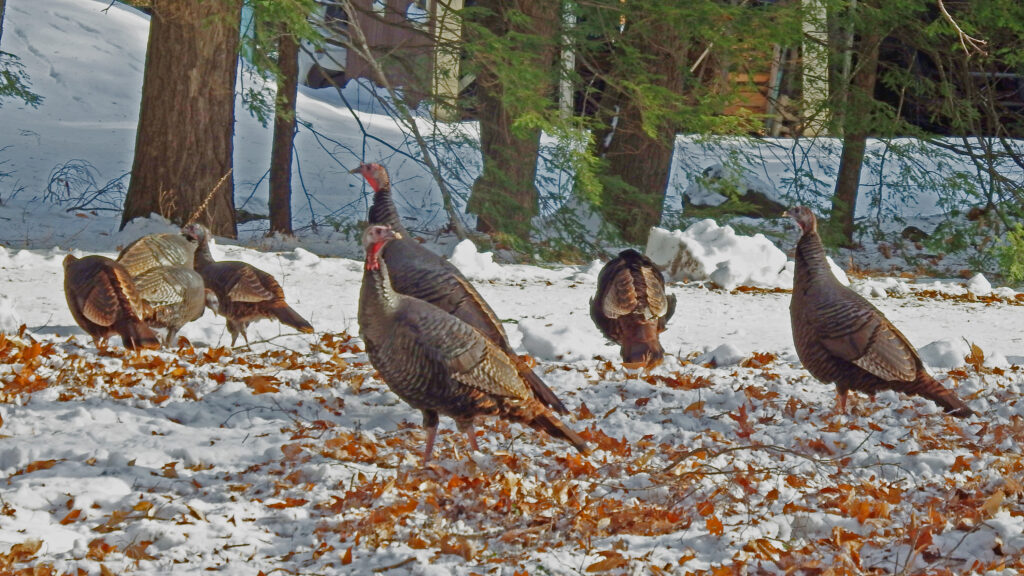
Things you may not know about wild turkeys in Maine
By Bob Duchesne
I watch birds. Occasionally I eat them. Next week on Thanksgiving, there will be a drumstick on my plate next to the cranberry sauce and mashed potatoes.
It is likely that wild turkey was on the banquet table at that first Thanksgiving in 1621, although not the only meat. Some sources say the Native Americans brought deer to the feast. Turkey was such an important food source for indigenous people that they intentionally burned small patches of forest, creating meadows and food resources for the birds.
Turkeys became equally popular with colonists throughout North and Central America. In the 1500s, the Spanish brought turkeys back to Europe, likely from Mexico.
The Mexican subspecies has white tail tips. All other subspecies have brown tail tips. Eventually, all of the brown color was bred out of domesticated turkeys, for cosmetic reasons. White pinfeathers are less visible on a plucked bird.

TURKEYS — Wild turkeys, which are native to North America, can be found just about everywhere in Maine.
Wild turkeys are exclusively a New World species, inhabiting every state except Alaska. Yes, that includes Hawaii, where they were introduced in 1815. Small breeding colonies still exist on at least four islands.
There are five subspecies overall, with distinctly different populations in Florida, southern Texas along the Rio Grande, southern Arizona and New Mexico, and certain mountainous regions of the West. Our own eastern wild turkey is the most widely distributed.
The wild turkey almost disappeared. At one time, it was the primary game bird in North America. Unregulated hunting and habitat loss decimated the species. Reintroduction efforts began in several states about 50 years ago. Since then, they’ve done so well that you can hunt them in all 49 states that have breeding populations.
The first reintroduction attempt in Maine occurred in 1977. It’s hard to fathom now, but turkeys were difficult to reestablish here. Nine years after they were reintroduced, legal hunting resumed. There were 500 hunting permits issued in 1986, but only nine turkeys were tagged.
Nowadays, Maine has flourishing populations statewide. Turkeys can be easy and entertaining to watch. Courtship begins in winter, and the male continues to strut his stuff well into spring.
The tom’s head and neck become brightly colored in mating season, and the color can change with his mood. The whiter the head and neck, the more excited he is.
Because virtually every predator in North America thinks turkeys are tasty, young poults are in constant peril. Turkeys reduce the threat by roosting in trees, but it takes at least five weeks before the poults can fly up there. Once they make it that far, their odds of survival multiply.
The average lifespan of a turkey is 10 years.
Turkeys counter the threat of predation by making a lot of babies. Toms mate with as many hens as they can. They are so aggressive, they occasionally attack shiny hubcaps, thinking the reflection is a rival. After mating, dads play no further role as parents.
Mom’s job is to lay a lot of eggs — up to 17 in a brood. Youngsters are able to leave the nest within 24 hours of hatching, and start foraging on their own just a few days later. Thereafter, the hen’s remaining chore is to provide protection. One or more families often gather into bigger groups called rafters for increased safety.
Wild turkeys have excellent eyesight in daylight, but poor vision at night. Understandably, that makes them skittish around sundown. As daylight fades, turkeys fly onto lower tree limbs, then move upward from limb to limb until they feel comfortable.
They understandably fear owls, a factoid that hunters use to their advantage. A predawn trick to locate roosting turkeys is to play an owl call, and listen for the gobble of nervous birds. I’ve never actually tried that.
Since Maine now has so many turkeys, it’s become easier to watch their behavior. They can run and fly, but mostly get around by walking. Interestingly, females tend to fly from danger. Males more often run.
Turkeys are not just sociable with each other. They often gather around other foraging creatures, particularly deer and squirrels. Biologists suspect that they benefit from the additional vigilance of other species. Also, they all like acorns.
I enjoy testing turkeys’ tolerance. Turkeys regard humans with deep suspicion, given that we’ve been hunting them for centuries. But they’re also comfortable on the fringe of neighborhoods, often foraging in backyards.
They will flee the moment they suspect a hunter, so I try not to look like one. When I encounter turkeys, I don’t stare or make direct movements toward them. I walk at a casual pace, just to see how they react.
I’m weird that way.